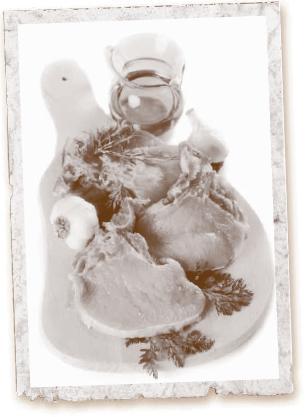America I AM Pass It Down Cookbook (16 page)
Pigs were an easy source of meat in the colonies because they were easy to raise and provided plenty of flesh. Used for fresh cuts as well as cured meats like salt pork, they were often the most plentiful livestock on any farm. Of course, farms were most often worked by slaves, for whom only the throwaway parts of the pig were available. These included feet, ears, snouts, and organ meats. African Americans found ways to use it all, from stuffing intestines for chitlins (chitterlings) to using a bit of salt, smoked pork, or pork rind to add flavor to what they could grow in their small kitchen garden.Even after slavery ended, particularly in the Jim Crow South, subsistence farming by sharecroppers provided little more by way of either freedom or food, and the skills learned in the bad old plantations days served them well.
Today, pork is a mainstay of soul food—although not the healthiest one because of its high fat content—especially when using the lesser quality cuts that are often most affordable. Consider substituting smoked turkey or turkey bacon in greens or rice dishes that normally call for pork—and save the pork for special occasions when a little extra indulgence is on the menu.

North Carolina Style Ham Hocks
Harlem, New York
SERVES 6 TO 8

Ms. Fannie Pennington was ninety-five years old when she submitted this recipe. It first appeared in
Food for the Soul, Recipes from Harlem’s Abyssinian Baptist Church
(Random House) where she is a devoted member. “I’m nearly ninety now,” she wrote when the book was first published in 2005, “so I don’t cook very often. But if I want ham hocks, I know how to make them. I always make them in my iron pot. This recipe came from my mama, Hattie, who was born and raised in rural Macon, North Carolina. She married Papa and moved up north to New York with him. Mama always served this with hot cornbread (see Sylvia’s Spoon Bread recipe,
page
50
) and butter. Papa loved her ham hocks, and so did the rest of our family. Papa would always say, ‘Make sure to drink that juice. It’s good for you. That is pot-lickin’ juice.’”
4 smoked ham hocks
2 slices salt pork
1 medium onion, chopped
2 garlic cloves, minced
2 bunches kale, stalks off
1 red bell pepper, cored, seeded, and quartered
4 small white turnips, quartered
black pepper
Place ham hocks and salt pork in a pot with 8 quarts of water and bring to a boil over high heat.
Remove the salt pork when broth is salty enough for your taste.
Add the onion and garlic and boil for 1½ hours or until they are tender.
Add the kale, red pepper, and turnips. Season with pepper to taste, and simmer until kale is tender. The total cooking time will be about 2–2½ hours.
Anita Dawkins’s Pork & Sauerkraut
Lithonia, Georgia
SERVES 4

Anita Dawkins makes this dish every New Year’s Day. Its comforting simplicity makes it ideal for any winter’s day. She serves it over homemade mashed potatoes on her overflowing New Year’s dinner table.
1 4-pound center-cut bone-in pork loin (rib) roast
¼ teaspoon salt
½ teaspoon black pepper
¼ cup vegetable shortening
1 cup water
1 large onion, sliced
1-pound bag or jar of sauerkraut
Pass It Down TIP
Vegetable shortenings are high in trans fats. Substitute canola oil for a heart-healthy omega acid-rich substitute.
Preheat oven to 350° F. Sprinkle the pork with the salt and half the pepper. Set aside.
Melt the vegetable shortening or oil (see tip below) in a large skillet over medium-high heat. Add the pork loin and sear on all sides until golden brown, about 7–10 minutes per side.
Remove the pork loin from the skillet and place it in a roasting pan or Dutch oven. Add the pan drippings from the skillet to the roasting pan with the water, onion, sauerkraut, and remaining pepper.
Cover and bake for two hours or until pork is fork tender. Serve with mashed potatoes.
Donna Daniels’ Pork Chops with Shallots, Lemon, and Capers
Guilford, Connecticut
SERVES 4
Perhaps because of her parents’ Southern roots or the affordability of pork chops, Donna Daniels says her family ate pork chops once a week while she was growing up in Philadelphia. “I’m sure the fact that they were relatively quick and easy to cook would have been a help to my mother, who was a very busy and dedicated public school teacher. Her preparation was simple: The chops were seasoned with salt and pepper, pan fried, and then smothered. Her pan drippings were the best and she often served her chops with rice, a perfect conductor for the drippings.” Dr. Daniels’ recipe builds on her mother’s and uses tricks she learned from cookbook author Mark Bittman. “I learned from his suggestions and innovated on my mother’s approach while using some flavors that I love: Marash chile flakes, shallots, and capers,” she says. “I see this recipe as an extension of my mother’s, a tribute really, but with a touch of her daughter’s curiosity about other cuisines.”
4 center-cut loin pork chops, bone-in, about 1 inch thick
kosher salt
freshly ground black pepper
2 teaspoons Marash chile flakes (available in Middle Eastern markets) or paprika
4 tablespoons olive oil
½ cup dry white wine
1 teaspoon minced garlic
4 tablespoons minced shallots
½ cup chicken or vegetable stock
1 heaping tablespoon capers
1 tablespoon sweet butter
1 tablespoon freshly squeezed lemon juice
4–5 tablespoons finely chopped flat-leaf parsley for garnish
Season chops with salt, pepper, and Marash chile flakes.
In a small skillet, add 1 tablespoon of the olive oil and heat on medium-high heat for 1 minute. Add the garlic, cook 45 seconds to 1 minute, then add the shallots and sauté another 2 minutes. Remove from heat and set aside.
Heat a large skillet over medium-high heat for 2–3 minutes. Add the remaining 3 tablespoons of olive oil and heat 30 seconds. Add the pork chops and raise heat to high. Brown chops on both sides, moving them around so they develop good color all over, no longer than 4 minutes total.
Reduce heat to medium. Add the wine, garlic, and shallot mixture to pork chops. Cook, turning the chops once or twice, until the wine is evaporated, about 3 minutes. Add the stock, turn the heat down to low, cover, and cook for 10–12 minutes, turning chops once or twice. Add capers and cook another 2–3 minutes until chops are tender but not dry. When done, they’ll be firm to the touch.
Transfer the pork chops to a platter. If the pan juices are very thin, continue to cook them, stirring and scraping the bottom of the pan until the liquid is reduced slightly. Stir in the butter and lemon juice, pour over chops, garnish with parsley, and serve with rice or baked potatoes.

Peach-Glazed Easter Ham
Olathe, Kansas
SERVES 10 TO 12

Renea Feagin is a dedicated wife and mother who loves to cook and bake. A self-taught cook who says she is at her most creative in the kitchen preparing meals for her three kids and two grandkids, Ms. Feagin’s Peach-Glazed Easter Ham recipe originally came from her friend Annie—and then she added her own twists. “The final result was a hit with my husband at our 2005 Thanksgiving dinner,” she says. “No more waiting in line at those expensive ham stores the day before Easter or Christmas. This recipe is a keeper and is sure to be passed down from generation to generation.”
2 tablespoons whole cloves
2 cups packed brown sugar
1 stick butter
¼ cup orange juice
1 16-ounce can peaches with the juice
¼ cup spicy brown mustard
½ cup peach or apricot preserves
1 teaspoon cinnamon
2 teaspoons allspice
1 teaspoon ginger
1 10–14-pound precooked ham
1 large plastic marinating bag with twist tie
Pass It Down TIP
Renea Feagin says you kick this recipe up a notch or two by adding 2 tablespoons of peach liqueur, such as schnapps, to the peach glaze before baking.
Mix 1 tablespoon of the cloves with brown sugar, butter, orange juice, liquid from peaches, mustard, preserves, cinnamon, allspice, and ginger together in a large saucepan. Cook on medium heat until mixture becomes thick and bubbly. Remove from heat and let cool.
Rinse ham and pat dry. Press the remaining cloves evenly all over the ham. Place ham in the plastic roasting bag and pour the cooled peach glaze over ham. The glaze will be very thick.
Close the bag tightly with twist tie and leave the ham in refrigerator overnight. Next day, remove it from the refrigerator and put peaches on top, securing with toothpicks. Place ham on cooking rack and put in a baking pan. Pour the glaze from the marinating bag all over ham.
Cover the ham tightly with foil and place in a preheated 325° F oven. Bake 18 minutes per pound. Cook the ham 1–1½ hours covered, then remove the foil and finish cooking. Baste ham with the pan drippings every 20 minutes.